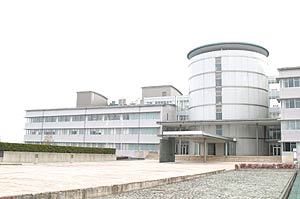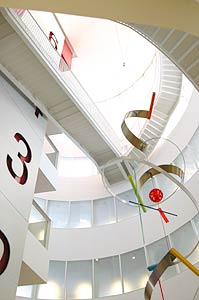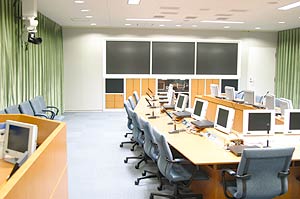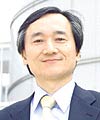Thinking of the communication environment through interdisciplinary research
—NTT Communication Science Laboratories, which belongs to the Science and Core Technology Laboratory Group, is a source of new principles and concepts. It is divided into two sites at Keihanna and Atsugi. How do you go about coordinating the two locations?
NTT Communication Science Laboratories (NTT CS Labs.) is the only group of laboratories in NTT with offices in the Kansai area (Photos 1 and 2). This gives us a sense of mission. Although opportunities for face-to-face contact between the two sites are limited, we communicate on a regular basis by videoconferencing (Photo 3). In this way, we can share lectures, debriefing sessions from individual laboratories, and other events. These are not simply one-way reports—questions may be asked from either side.

Photo 1. Research building.
Keihanna Building, NTT's R&D base in western Japan. This building embodies two themes: First, it promotes a natural exchange between the interior and exterior of the building while generating a sense of continuous space. Second, the corridor and staircase space connecting each floor in the building are designed to be places for exchanges between people and people and between people and nature.

Photo 2. Entrance hall.
Symbol of the Keihanna Building. The six-floor stairwell, which is illuminated by soft, natural light passing through semitransparent glass blocks, consists of a helical staircase and an elevator shaft.

Photo 3. Conventional videoconferencing room.
Even though NTT CS Labs. is divided into two sites at Keihanna in western Japan and Atsugi in eastern Japan, researchers at both sites interface frequently through videoconferencing.
In addition to this conventional videoconference system, we have also installed the "t-Room" communication tool at both sites. This reflects how we ourselves are searching for and implementing schemes for overcoming the distance that separates our two sites. If we were not separated in this way, no doubt we would not be exploring the use of this tool. Unfortunate circumstances sometimes prove to have a positive effect on research and development.
—The name itself of these laboratories starts off with the word "communication," which we can think of as the origin of NTT. With this in mind, what are the research fields that NTT CS Labs. is actually involved in?
Our objective is to create new communication environments that involve human aspects, media aspects, and the humanities in general. We research fields that would be difficult to identify in the traditional way of classifying fields. In short, CS Labs. is a unique research institution where traditional research fields merge and interdisciplinary research is the norm. For example, there is a group in the Human and Information Science Laboratory at Atsugi that targets human beings in its research.
I believe that there are many researchers on our staff that take a lot of pride in what they do. They are highly motivated and have a real sense of mission. There are also many fixed-term researchers and students from overseas serving internships at CS Labs., and they contribute to the energetic environment that I can feel throughout our laboratories.
Incorporating a human perspective in R&D of technology
—Does interdisciplinary research mean an original approach even to fields described by that overly used word communication?
The field of human interfaces is, of course, being researched at other research institutions from a technical point of view. But in terms of how the human factor should be perceived and how R&D should proceed from the viewpoint of designing a total communication environment, I don't think such an approach is being taken. If we decide to research human information, for example, the way in which technology can be useful will change according to our understanding of human beings.
NTT was once called a carrier or telecom, but we can recognize it as being a communication company in the original sense of those words. But there is still much that is not understood about communication. Even in the world of communications, there have been times when humans have had to adapt to technological developments. Putting aside questions of necessity, technology has progressed steadily in a technology-driven manner. And at times, technology has become so complicated or so advanced that it has become a source of stress in people, creating an effect just the opposite of what was originally intended.
Under these circumstances, I believe that there is a need to rethink the meaning of technology in our lives. I think that the mission of our research laboratories, whose name begins with the word communication, is to consider what our role in the communication environment of the future should be and how we should pursue technology development to that end, and to search for our future direction.
—What specific themes are being promoted at NTT CS Labs. from the medium-to-long-term viewpoint?
Last year, we began promoting the keyword miraisoron, which loosely translates to "envision and discuss the future." It expresses a desire to establish forums where research and development from the medium-to-long-term viewpoint can be discussed. The idea here is to enable the discussion and exchange of ideas about the future and how it should develop. By putting this approach into practice, I hope to provide a platform that enables researchers to begin to reconsider human beings themselves, the society that surrounds them, and the true meaning of technology.
In 2006, we also held a symposium on "ambient intelligence" [1]. This symposium provided researchers from a wide variety of fields an opportunity to come together and talk about current problems and the direction that R&D should take in the future. Various comments were received at the end of the symposium, but the one that convinced me that the objective of the symposium was achieved was: "This type of thinking with such an outlook is not typical of NTT!"
Communicating with human senses
—Is there anything in particular among recent R&D efforts at NTT CS Labs. that you would like to make known?
Well, one policy that we have is to divide a research project into three layers: conceptualizing, merging, and specializing. The top layer consists of ideas and concepts while the bottom layer corresponds to specialized areas in which we have been involved for some time. The middle layer, meanwhile, corresponds to a merging of ideas and technologies where the concepts of the uppermost layer are given concrete form. The role of this layer is very important—it must give specific shape to the content of the top layer. But this, in turn, requires lots of technology in the bottom layer. As a result, the middle layer also has a feedback relationship with the technology of the bottom layer in which new problems may be discovered in an attempt to materialize top-layer ideas.
Above all, we have given special attention to the middle layer from which we have been developing three "rooms" [2]–[4]. As research progressed, we found that we could discover many more problems in this way than we would have been able to find with just a desk-top approach. We also found that middle-layer activities could be helpful during top-layer discussions, by enabling the drawing of detailed images, for example. All in all, the middle layer has proved to be quite beneficial in various ways.
—These room projects were presented at the open house* [5] held two years ago at NTT CS Labs. Could you tell us about them?
Let me outline the t-Room [2] project for you. This is a nearly circular environment with large-screen displays arranged along the periphery with people situated at the center. The exact same environment is installed here in the Keihanna Building and at the Atsugi site, and the two rooms are connected by NTT's B-FLET'S broadband service. Of course, researchers at the other site appear on the displays, but the t-Room makes them feel as if they are actually present alongside the people that are actually in the room. One definite difference between the t-Room and other videoconferencing rooms is that the human senses are used to facilitate communication. The t-Room enables a local participant to feel the presence of a remote participant using very ordinary human impressions as in "that person feels close to me" and "that person is reacting to me."
Communication in modern times began with the ability to convey one's voice, that is, with the telephone. This corresponds to something that conveys the medium of sound. If we now add moving pictures, we get a videophone, and if we communicate by sending text and pictures, we have e-mail. Such has been the progress of technology. But communication in its original meaning includes a variety of elements in addition to that which can be obtained between people by the sense of sight and the sense of hearing. These include the surrounding environment and positional relationships. In contrast to high-reality environments, these elements make up a communication environment that makes full use of human senses. We call this tool the "future phone." It is exactly this communication environment that we are aiming for.
| * |
Open house: An information-sharing event held to provide a deeper understanding of the research being performed at Communication Science Laboratories. This year, it was held on June 7–8, 2007 under the title "Open House × Miraisoron". |
References
| [1] |
K. Dohsaka, Y. Minami, A. Mori, and T. Kondo, "Report on Ambient Intelligence Symposium 2006—The Future: A Tapestry Woven from Threads of Intelligence, NTT Technical Review, Vol. 4, No. 12, pp. 64–69, 2006. |
| [2] |
K. Hirata, Y. Harada, T. Takada, S. Aoyagi, Y. Shirai, N. Yamashita, and J. Yamato, " The t-Room: Toward the Future Phone, NTT Technical Review, Vol. 4, No. 12, pp. 26–33, 2006. |
| [3] |
T. Okadome, T. Maekawa, T. Hattori, and Y. Yanagisawa, "Event Searching in the Real World, NTT Technical Review, Vol. 4, No. 12, pp. 34–37, 2006. |
| [4] |
E. Maeda, Y. Minami, M. Miyoshi, M. Sawaki, H. Sawada, A. Nakamura, J. Yamato, T. Yamada, and R. Higashinaka, "The World of Mushrooms—A Transdisciplinary Approach to Human-Computer Interaction with Ambient Intelligence, NTT Technical Review, Vol. 4, No. 12, pp. 17–25, 2006. |
| [5] |
http://www.kecl.ntt.co.jp/openhouse/2007/index.html (in Japanese). |
↑ TOP












